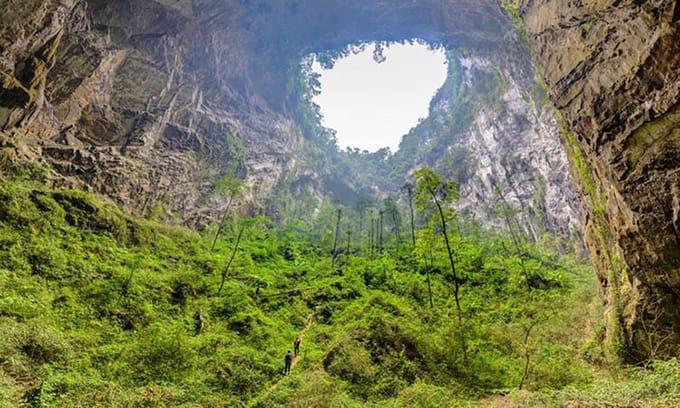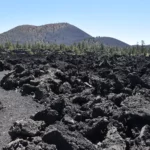Prepare to be mesmerized by Hang Son Doong, the biggest cave on Earth! Nestled within Vietnam’s Phong Nha-Ke Bang National Park, a designated UNESCO World Heritage Site, this subterranean paradise has captured the imaginations of adventurers, scientists, and nature enthusiasts alike. Hang Son Doong, with its colossal chambers, towering stalagmites, and hidden rivers, stands as a testament to the awe-inspiring power of nature. Embark on a journey to uncover the fascinating facts that make Hang Son Doong a true natural wonder, from its unique geological formations and amazing wildlife to its cultural history and the air of mystery that surrounds it.
Hang Son Doong Facts
Get ready to explore Hang Son Doong, a cave so massive it could easily swallow entire city blocks. Located in Vietnam’s Phong Nha-Ke Bang National Park, this natural wonder redefines our understanding of scale and beauty. But Hang Son Doong is much more than just its size.
Imagine a subterranean world teeming with life – towering ferns stretching towards the slivers of sunlight that penetrate the cave’s depths, unusual insects found nowhere else on Earth, and even clouds forming within the cave’s colossal chambers. This self-contained ecosystem has provided scientists with invaluable insights into how life can thrive in the most extreme environments.
The discovery of Hang Son Doong was a watershed moment for the scientific community, revolutionizing our understanding of cave formation and the adaptability of life. This untouched ecosystem serves as a giant natural laboratory, offering endless opportunities for research and discovery.
For those seeking adventure, a journey through Hang Son Doong is an experience unlike any other. Multi-day treks delve deep into the Earth, leading explorers through mind-blowing rock formations, across underground rivers, and into the heart of the planet’s raw beauty.
Hang Son Doong is more than just a cave; it’s a symbol of the Earth’s boundless capacity for wonder. Its existence reminds us that hidden marvels await those who dare to explore the unknown and that our planet holds secrets yet to be revealed.
What are some fun facts about Son Doong?
Hang Son Doong’s grandeur extends far beyond its record-breaking size. Imagine a cave so vast that it houses its own weather system, complete with rivers, jungles, and even cloud formations. This self-contained world, hidden beneath the earth’s surface, challenges our perceptions of what’s possible.
One of the cave’s most impressive features is the “Hand of God,” a massive stalagmite towering over 80 meters high – taller than the Statue of Liberty! This natural wonder stands as a testament to the eons it took for Hang Son Doong to take shape.
But Hang Son Doong is not just about size and geological formations; it’s also a haven for unique flora and fauna. Giant ferns thrive in the dim light, strange insects have adapted to a life without sunlight, and who knows what other undiscovered species might call this cave home?
Exploring Hang Son Doong is not for the faint of heart. It’s a true adventure, involving days of trekking through incredible rock formations, wading through underground rivers, and even rappelling down cliffs. It’s a challenge that rewards the brave with an experience they’ll carry with them forever.
Hang Son Doong is much more than just a cave; it’s a natural wonder of epic proportions, a scientific marvel, and a testament to the power and beauty of the natural world.
Why is Hang Son Doong Famous?
Hang Son Doong’s claim to fame goes far beyond its title as the world’s largest cave. Imagine a subterranean world so vast that it could comfortably accommodate entire city blocks. But Hang Son Doong’s allure extends beyond its size; it’s a place where adventure and scientific discovery intertwine.
Imagine a river carving its way through the cave’s heart, its path hidden in the cool, damp darkness. Depending on the time of year, this river can swell, creating a vast, subterranean lake – a sight that few have had the privilege to witness. Sunlight spills through massive collapsed sections of the ceiling, painting the cave walls with intricate patterns of light and shadow, creating an atmosphere that borders on the magical.
Hang Son Doong is more than just a feast for the eyes; it’s a treasure trove for the scientific community. Ancient fossils, scattered throughout the cave, provide clues to what life might have been like millions of years ago, helping scientists piece together the story of the cave’s formation and the evolution of life in these extreme environments.
The cave teems with life: monkeys, birds, and bats have all found a way to make this underground world their home. Their presence begs the question: what other creatures might lurk in the shadows, waiting to be discovered?
For the adventurous at heart, Hang Son Doong offers an unparalleled opportunity for exploration. Multi-day treks lead intrepid explorers through massive chambers, over challenging terrain, and even involve camping out under the cave’s “sky.” Due to its remote location and the physical challenges of reaching it, Hang Son Doong remains a prize for those bold enough to seek it out.
And perhaps the most alluring aspect of Hang Son Doong is that we’re still learning about it. Each expedition, each study, reveals something new about this subterranean giant. Hidden within its depths are likely more secrets, more wonders just waiting to be brought to light. This air of mystery, this sense of ongoing discovery, is part of what makes Hang Son Doong so captivating—a reminder of the vastness and mystery of our planet.
Is Son Doong fully explored?
Hang Son Doong, a cave so massive it dwarfs its closest competitor, is practically a world unto itself. Imagine a subterranean city, complete with a rushing river, teeming with life, and adorned with stunning rock formations. Its scale is almost too vast to comprehend. But even with its colossal size, parts of Son Doong remain shrouded in mystery.
Exploring Hang Son Doong is not as simple as traversing a well-marked path. Every expedition into its depths seems to reveal something new: hidden chambers, previously unknown species, geological formations that defy our understanding of what’s possible. Each discovery adds a new piece to the puzzle, bringing us closer to understanding this natural wonder but also reminding us how much we have yet to learn.
So, has Son Doong been fully explored? The answer is a resounding no. And that’s part of what makes it so alluring. The possibility of what remains hidden within its depths, waiting to be unearthed, is a thrilling thought, a testament to the enduring power of exploration and discovery.
Do animals live in Son Doong Cave?
Hang Son Doong isn’t just the world’s largest cave; it’s a thriving ecosystem, a testament to nature’s ability to adapt and flourish in the most unexpected places. Within its depths live a diverse array of creatures, from tiny insects and spiders to birds soaring through its massive chambers and even monkeys making their home in the jungle that spills into the cave’s entrance.
Hang Son Doong’s long isolation from the outside world makes it a particularly fascinating subject for biologists. Some of the creatures discovered within its depths have never been observed anywhere else on Earth, raising the possibility of discovering entirely new species with each expedition. Many of these animals have adapted to life in perpetual darkness, some even losing their sight entirely – a testament to the power of evolution to shape life in the most extreme environments.
While scientists are still working to catalog the full diversity of life within Hang Son Doong, it’s clear that this cave is a hotspot for biodiversity. Every expedition seems to uncover something new, reminding us that even in the darkest corners of our planet, life finds a way.
What has been found in Son Doong?
Hang Son Doong is more than just a massive void; it’s a treasure trove of natural wonders, each more awe-inspiring than the last. Imagine walking through a cave and encountering perfectly round, pearly spheres scattered across the floor. These are cave pearls, formed over millennia by dripping water, each layer of minerals adding to their smooth, lustrous surface. Some of the cave pearls found in Hang Son Doong are truly massive, dwarfing those found in other caves around the world.
And then there’s the “Hand of Dog,” the world’s largest known stalagmite, stretching over 80 meters high – a testament to the immense power of geological processes acting over millions of years. This colossal rock formation, formed by countless drips of mineral-laden water, is just one example of the breathtaking formations found within the cave.
Hang Son Doong is more than just rocks and minerals; it’s home to a subterranean river that cuts through its heart. This rushing torrent of water adds to the cave’s sense of dynamism, and during the rainy season, parts of the cave flood, creating temporary lakes that further enhance its ethereal beauty.
Despite its perpetual darkness, Hang Son Doong supports a surprising array of life. Giant ferns thrive in the faint light that filters down from the cave’s massive ceiling openings, while unusual insects, found nowhere else on Earth, have carved out their niche in this unique environment. Birds nest in the cave’s high ceilings, adding their songs to the symphony of dripping water and rushing wind.
Perhaps the most intriguing discovery within Hang Son Doong is the evidence of ancient humans. Explorers have found tools and pottery fragments, suggesting that humans sought shelter and refuge in this cave hundreds, if not thousands, of years ago. These artifacts offer a glimpse into the lives of these early inhabitants, leaving us to wonder what they thought of this incredible subterranean world.
Exploration of Hang Son Doong is ongoing, and with each expedition, the possibility of new discoveries arises. This cave, a testament to the power and mystery of the natural world, continues to captivate our imaginations, reminding us that there’s still much to learn about our planet and the wonders it holds.
Are Tourists Allowed in Son Doong Cave?
Yes, you can visit Hang Son Doong, but access is a carefully controlled privilege. Preserving the cave’s pristine environment is paramount, and only a limited number of visitors are allowed each year.
Imagine Hang Son Doong as a rare, delicate flower, its beauty preserved by strict conservation efforts. To ensure its protection, only 1,000 visitors are permitted to enter annually, and even then, access is strictly regulated. Only one company, Oxalis Adventure Tours, is authorized to lead expeditions into the cave.
This exclusivity is due in part to the cave’s immense size and the challenges of navigating its interior. A typical tour is a five-day expedition, involving trekking through challenging terrain, wading through underground rivers, and camping in the cave’s massive chambers. It’s not an experience for the faint of heart, but for those who seek adventure and are willing to respect the cave’s delicate ecosystem, it’s an experience of a lifetime.
So, while a trip to Hang Son Doong is certainly possible, it’s not a simple sightseeing tour. It’s an expedition, a journey into the heart of one of Earth’s most incredible natural wonders.
Just so you know:
- Tours are only conducted from February to August due to weather conditions and to minimize the impact on the cave’s ecosystem.
- You need to be in good physical condition to participate in a Hang Son Doong expedition. The trek involves a significant amount of hiking and exploring challenging terrain.
Did you know that the Perito Moreno Glacier is one of the most accessible glaciers in the world? glacier perito moreno facts
Did you know that Mauna Loa is the largest volcano on Earth in terms of volume? interesting facts about mauna loa volcano
- Star Ring Trends: Etsy vs Amazon - March 28, 2025
- Boost Pollinator Habitats: Baby Blue Eyes Sustainable Farming Guide - March 28, 2025
- Protect Big Black Bears: Effective Conservation Strategies - March 28, 2025
















